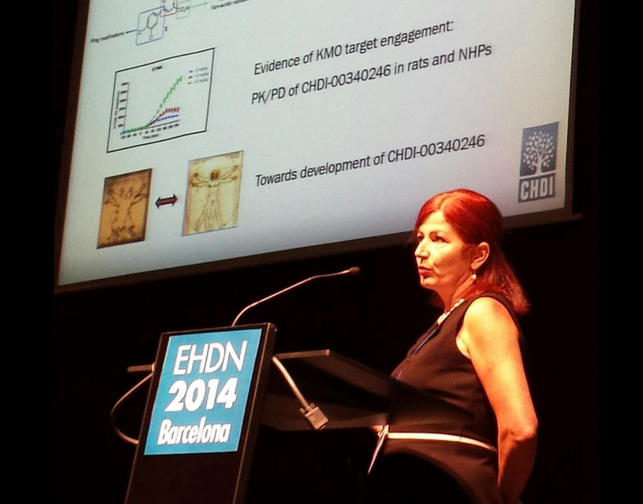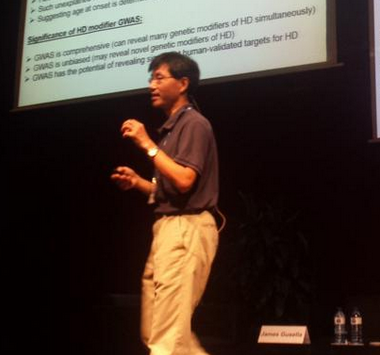
EuroBuzz 2014: day one
Highlights from the opening day of the 2014 European Huntington's Disease network in Barcelona, Spain

Join Jeff and Ed as we tweet live from the 2014 European Huntington’s Disease Network meeting in Barcelona! Exciting science ahead!
Prof Bernhard Landwehrmeyer opens the 2014 European Huntington’s Disease Network meeting in Barcelona
EHDN is a huge network of scientists, clinicians and HD family members across Europe. 2014 is EHDN’s 10th Anniversary!

The day starts with a lecture from Prof Sarah Tabrizi, who reminds us that we have to understand HD in humans, not just flies and mice
Observational clinical trials like PREDICT-HD, TRACK-HD and ENROLL-HD help us understand how symptoms progress in people with HD
Tabrizi: the goal is to intervene early to prevent Huntington’s completely. “I hope to achieve this in my professional lifetime”
Observational studies have revealed that shrinkage in very specific brain regions predicts when people will have HD symptoms
Tabrizi: But other changes in HD mutation carriers, including high levels of apathy, also predict onset of symptoms
Tabrizi: HD mutation carriers, even before they have symptoms, have difficulty recognizing negative facial emotions
Tabrizi: We shouldn’t ignore symptoms like apathy and difficulty in emotional recognition, because they can cause major problems
Tabrizi: A study called TRACK-ON was designed to study how parts of the brain communicate with one another in the face of HD
Tabrizi: The ‘wiring diagram’ of vulnerable brain regions in HD is altered in ways that might help explain patients symptoms
Tabrizi: Using fancy math, researchers examined TRACK-ON brain imaging data and show that the HD brain has reduced connections
Tabrizi: New data suggests that when one part of the brain becomes sick in HD, other regions increase their activity to compensate
Tabrizi: A major remaining question is why some HD patients have fast and some have slow progression
Prof Roger Barker from Cambridge University presenting a roundup of animal models used in HD
Barker: animal models are useful but we must remember they’re not humand when we interpret what they tell us
Barker: If you take one message from my talk, it’s “animals cannot talk!” So they can’t describe their symptoms, like HD patients
Barker: to show signs like HD, animal models have very long ‘CAG repeat’ counts, some much bigger than we see in real patients
Barker has created a virtual reality swimming pool to recreate in patients a widely used mouse test
Barker: HD is a disease of people, but going between animal models and people can help us best understand HD
Bernhard Landwehrmeyer again, giving an update on the Enroll-HD study http://enroll-hd.org
Landwehrmeyer: ENROLL-HD was developed because ‘we need speed’.
BL: enroll is a world wide study with big ambitions, aiming to study 25,000 individuals!
BL: why do some people experience HD symptoms early, and some late? What factors can explain this?
BL: a multi-year study of more than 4000 volunteers suggests a new gene that could modify the age of onset of HD
BL: these results reveal why we need huge members of volunteers for HD observational studies like ENROLL
BL: enroll-HD has 102 active sites around the world, with more than 3000 participants
BL: you do not need to have a predictive test for HD to be involved in ENROLL-HD – anyone can participate
BL: hopefully the large group of patients in the ENROLL-HD study can help fill up drug studies quickly with the right participants
Excitement for next session on ‘modifiers’ of HD. Genetic Modifiers international collaboration has made a big breakthrough
First Jan Frich from Oslo is talking about environmental modifiers of HD
Frich: an environmental modifier is anything a person can do, or encounter, that alters how HD affects them
Exercise, smoking, diet, pollution, occupation are examples of potential ‘environmental modifiers’
Frich has conducted a study of 1 year intensive programmed activity as a way of improving symptoms in HD
Message: physical activity is helpful for many aspects of Huntington’s disease
Jong-Min Lee from Massachusetts General Hospital is presenting the genetic modifiers work on behalf of international group
Genetic differences between people can affect when HD symptoms begin. We call these ‘genetic modifiers’.
The biggest ‘genetic modifier’ is the CAG count in the HD gene itself. But differences in other genes might affect HD as well
If we can find out what those genes are, they might tell us where to focus our drug development efforts
“Tabrizi: The goal is to intervene early to prevent Huntington’s completely. I hope to achieve this in my professional lifetime”
Advances in genetic technology let us look for genetic differences in thousands of people to see what changes speed or slow HD
It’s thanks to efforts like EHDN’s Registry study that we have enough samples and data to do these huge, important studies
A study this large takes years of hard work – the study discussed here began in 2008, and looked at 8 million genetic differences!
Interestingly, the researchers have found modifiers that are associated with having HD symptoms both later and earlier
When you test 8 million genetic variants in more than 4000 people, the math gets pretty complicated!
All the information generated in the huge modifier study will be freely available to researchers around the world
Leslie Jones of Cardiff University presenting exciting genetic modifier data
Jones describes the team’s efforts to understand how the mapped genetic changes actually change how genes function
The new genetic results suggest that something may be going wrong with the DNA proofreading that cells have to do to stay healthy
This is exciting because earlier work, in mice, suggested this DNA proofreading process is important in HD
Ed: The next science session is on ‘kynurenine mono-oxygenase’, or KMO.
Ed: KMO is a molecular machine that determines the balance of harmful and helpful chemicals in the brain.
Ed: KMO has been shown to be involved in HD in experiments in yeast, flies and mice.
Ed: blocking the activity of KMO should protect HD brains against some damage
Ed: You can read about KMO and some previous success with a KMO-inhibiting drug here
Ed: Laci Mrzljak of CHDI Foundation is presenting the latest on CHDI’s efforts to develop their KMO inhibitor drug ‘CHDI246’
Mrzljak: treating mice with CHDI246 helps the connections between brain cells to keep working properly
Mrzljak: CHDI246 treatment also improves brain activation when you do MRI scans of the HD mice
Letitia Toledo-Sherman, a ‘drug designer’ at CHDI, takes up the KMO story
LTS: CHDI has developed new methods for measuring the KMO-related chemicals in human patient spinal fluid
Ed: CHDI’s Chief Medical Officer Christina Sampaio is now talking about how we can get CHDI246 into human trials
Sampaio: To get CHDI246 into clinical trials we need biomarkers – ways of measuring whether the drug is working.
Sampaio: CHDI is setting up a big project to collect spinal fluid, to measure the balance of protective and harmful chemicals…
Sampaio: … the CHDI cerebrospinal fluid project will be led by a plucky young HD researcher called Dr Ed Wild
Sampaio: CHDI has detailed plans for getting CHDI246 into human trials and showing whether it works
Alexandra Durr from Paris: Between 1992-2013, 1,705 predictive tests for HD have been conducted at at Pitié-Salpêtrière Hospital in Paris
Durr: Only 5-25% of persons at risk for HD undergo predictive testing
Durr: Of people requesting predictive testing for HD, 63% complete the process and actually receive their result
Durr:Since 2000 there’s been no obvious increase in people requesting predictive testing at her center, despite more info available
Durr: The average age of people requesting predictive testing is about 35, and rarely from very young
Durr: about 70-80% of patients who received predictive testing results say they pay more attention to possible symptoms of HD
Durr: We should take the opportunity to try and run pre-symptomatic trials in HD, targeted at preventing onset of symptoms
Elizabeth McCusker considers whether diagnostic criteria in HD should be changed
McCusker: There’s no formal means of defining onset of HD, but rather clinical practice that has developed over years
McCusker: The diagnosis of HD is made in a complex environment, with possible family, social and other consequences for patients
McCusker: From the point of view of research, the formal diagnosis of HD may be coming too late
McCusker: Does diagnosis of HD help patients? There are ways that we can see at least some patients benefit from a clear diagnosis

McCusker: All the HD mutation carriers that have been studied pre-symptomatically are from the rare 5-20% of patients who are tested
McCusker: The issues around what constitutes a diagnosis of HD are complex and somewhat unique to each patient’s situation
David Craufurd addresses the EHDN on the question of whether HD patients, or pre-symptomatic mutation carriers, should have checkups
Craufurd: Behavioral symptoms are often more distressing than motor and cognitive ones for HD families
Craufurd: Symptomatic treatments for HD have improved dramatically over the last few decades
Craufurd: HD symptoms are a “moving target”, because the symptoms in a given individual change throughout the disease
Crufurd: Treating HD can be difficult, in part because patients can be unaware of their own symptoms or apathetic
Craufurd: We should have a program for HD patients that helps ensure they receive necessary treatments for their symptoms
Craufurd: Should HD mutation carriers regularly see medical professionals?
Craufurd: Some symptoms, like irritability and depression, seem to occur a long time before formal diagnosis of HD
Craufurd: There could be down-sides, as well as up-sides, to pre-symptomatic HD mutation carriers regularly attending HD clinics
Carufurd: Some people ‘cope by denial’, avoiding thinking about HD, and those people may have difficulty \ being in an HD clinic
Craufurd, on balance, thinks that it is beneficial for HD mutation carriers, as well as HD patients, to attend clinics
The final session of the day is focused on the development of ‘biomarkers’ for HD research
Biomarkers, measurable characteristics that can be quantified in people, are things like like brain imaging, or blood markers
We’d like to have things that are readily measurable in people that allow us to track the progression of HD more reliably
After years of work, studies like TRACK and PREDICT have provided a large number of potential biomarkers for HD
Blair Leavitt discusses how the findings of TRACK and PREDICT are already informing the design of new drug trials
Leavitt: if we follow HD patients for as long as 2 years, there are clear changes that can help inform clinical trials
Leavitt is interested in a technique called magnetic resonance spectroscopy, which measures the levels of specific brain chemicals
Leavitt’s team is developing these techniques to look at chemicals in HD patient brains
Specific brain chemicals are increased in the brains of HD patients over time, while others decrease
Some of these changes are even observed in the brains of HD mutation carriers that do not yet have disease
Leavitt’s team has also looked at the levels of specific chemicals in the blood that suggest increased inflammation in HD
Leavitt:proposed biomarkers should be measured by more than one lab, to ensure that they’re reproducible before being used in trials
Finally, Beth Borowsky, of the CHDI foundation, outlines the challenges of using biomarkers in clinical trials
BB: The point of biomarkers is to provide information that is useful in the clinic – either to tell you about HD or a drug effect
BB: Some biomarkers show how HD progress over time
BB: Other biomarkers let you measure the effect of a drug – for example, does your drug get into the right part of the brain?
BB: Drug development is a very long, and very expensive, process, even after all the basic lab work is complete
BB: Every trial ends in one of 3 ways – positive, negative or inconclusive. How can we use biomarkers to prevent inconclusive ones?
BB: We have a huge number of tools in our toolkit right now, thanks to years of study of HD patients. Which ones are most useful?
BB: In other diseases, things that were thought to be biomarkers turned out not to work in clinical trials- we have to be careful
BB: Until we have more clinical trials, we won’t know which proposed HD biomarkers actually tell us about the progress of HD
BB: Validating biomarkers is a kind of chicken and egg problem – we can’t prove they work until we have drugs that work!
BB: New trials, and upcoming trials, should include exploration of biomarkers as part of their design
BB: Trials of gene silencing which rely on invasive delivery, require good markers to prove that the drugs got where they need to go
Learn more
Sources & References
For more information about our disclosure policy see our FAQ…


